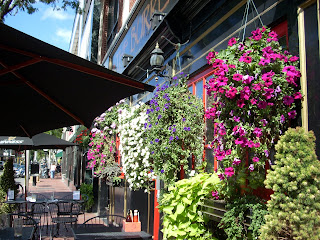
On Saturday I saw my reading group. We first started reading together twenty or so years ago, took a break for a while, and now meet once a month. We're friends, most of us writers. This last time we read "High Wind in Jamaica," which S. loves.
The group was divided. L. said Hughes was a dandy, interested only in style, and had no moral compass. A. disagreed; he was sure Hughes had a point of view about the treatment of blacks in Jamaica. I was interested in the shocks Hughes delivers without comment: the earthquake, the cat leaping through the fanlight, the death of John, etc. In the end we agreed that the novel went back and forth between the narrator's love for effects and a coherent point of view.
We all really came together when L. read passages of wonderful writing:
It was a hot night, even for those latitudes: and no moon. The suffused brilliance of the stars lit up everything close quite plainly, but showed nothing in the distance. The black masts towered up, clear against the jewelry, which seemed to swing slowly a little to one side, a little to the other, of their tapering points.
And:
When swimming under water, it is a very sobering thing suddenly to look a large octopus in the face. One never forgets it: one's respect, yet one's feeling of the hopelessness of any real intellectual sympathy. One is soon reduced to mere physical admiration, like any silly painter, of the cow-like tenderness of the eye, of the beautiful and infinitesimal mobility of that large and toothless mouth, which accepts as a matter of course that very water against which you, for your life's sake, must be holding your breath. There he reposes in a fold of rock, apparently weightless in the clear green medium but very large, his long arms, suppler than silk, coiled in repose, or stirring in recognition of your presence. Far above, everything is bounded by the surface of the air, like a bright window of glass. Contact with a small baby can conjure at least an echo of that feeling in those who are no obscured by an uprush of maternity to the brain.
Having myself had "an uprush of maternity to the brain," I feel that Hughes's comparison--contact with an octopus like contact with a baby--has momentarily cleared out that uprush. I remember how strange the newborn seemed, fresh out of the little ocean of the womb, the disproportion of the large head with its soft spot, the bare pink gums. It's a good thing there is a maternal instinct, or else we might like Hughes's narrator keep separate from our octopus-like babies.
On Saturday as we were getting ready to leave, L. told us about the new man in her life. The right man! She was happy. I could see it in her face and hear it in her voice. It is a fine thing to have someone you love and who loves you on the horizon. The children in "High Wind in Jamaica" do not.








_-_Youth_sitting_on_a_stone_(Nicola_Giancola),_1907.jpg)


































